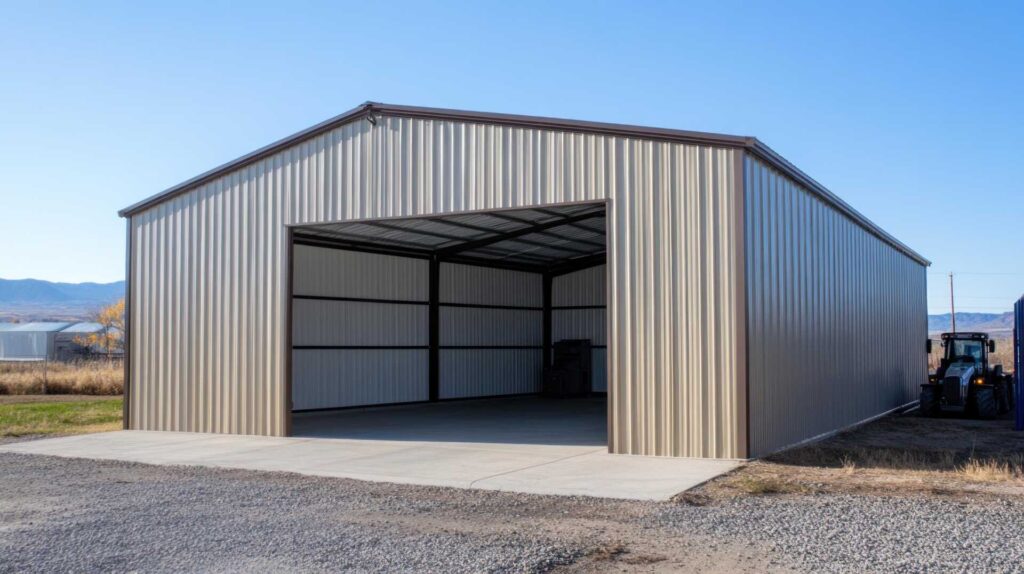
Contents
To improve energy efficiency in metal buildings, you need to encompass a variety of methods. From correct insulation placement and sealing openings to using reflective insulation and integrating thermal barriers, these strategies play a significant role. But what about efficient lighting solutions, high-grade roofing materials, and intelligent building automation? There are even more innovative techniques like daylight utilization and eco-friendly landscaping practices that can further enhance energy efficiency. The essence lies in a comprehensive approach that maximizes every aspect of your metal building.
Key Takeaways
- Proper installation of high-quality insulation reduces heat transfer.
- Sealing gaps and cracks minimizes air leakage.
- Use reflective insulation and spray foam for enhanced efficiency.
- Incorporate efficient lighting with LED and natural light.
- Implement smart ventilation and energy-efficient HVAC systems.
Insulation Strategies
To optimize energy efficiency in metal buildings, consider implementing effective insulation strategies. Proper insulation installation plays an important role in reducing heat transfer and maintaining a comfortable indoor environment. By creating thermal barriers within the building envelope, you can significantly decrease the energy needed for heating and cooling, leading to cost savings and improved sustainability.
When installing insulation in metal buildings, it’s vital to pay attention to areas that are prone to energy loss, such as walls, roofs, and floors. Utilizing high-quality insulation materials with appropriate R-values can enhance thermal resistance and prevent heat from escaping during the winter or entering during the summer. Additionally, sealing gaps and cracks in the building structure can further improve insulation performance and reduce air leakage, enhancing overall energy efficiency.
Thermal barriers, such as reflective insulation or spray foam, can effectively minimize heat transfer through radiation, conduction, and convection. Reflective insulation reflects radiant heat away from the building, while spray foam creates an air-tight seal that prevents thermal bridging.
Efficient Lighting Solutions
Consider integrating energy-saving lighting solutions to enhance the lighting system in metal buildings. LED lighting stands out as a top choice for increasing energy efficiency. LED lights consume considerably less energy than traditional incandescent bulbs, resulting in lower electricity bills and reduced environmental impact. By replacing outdated lighting fixtures with LED options, you can illuminate your metal building while reducing energy consumption.
Another effective strategy to enhance lighting in metal buildings is through natural light harvesting. This technique involves maximizing the use of natural sunlight to illuminate interior spaces, reducing the need for artificial lighting during daylight hours. Installing skylights, large windows, or light tubes can help bring in natural light, creating a brighter and more energy-efficient environment. By strategically placing these openings, you can effectively illuminate different areas of your metal building without solely relying on electric lighting.
Combining LED lighting with natural light-harvesting techniques can greatly improve the energy efficiency of your metal building’s lighting system. You will reduce energy costs and environmental impact, and you’ll also create a well-lit and comfortable space.
Embracing these efficient lighting solutions is a practical step towards achieving sustainability and maximizing the benefits of your metal building.
High-Quality Roofing Materials
Upgrade your metal building with high-quality roofing materials to enhance durability and energy efficiency. When it comes to improving energy efficiency in metal buildings, the choice of roofing materials plays a pivotal role. High-quality roofing materials provide better protection against environmental elements and contribute to building climate regulation.
Climate regulation is vital for maintaining a comfortable indoor environment and reducing the energy consumption of heating and cooling systems. By investing in top-tier roofing materials specifically crafted for energy efficiency, you can effectively regulate the temperature inside your metal building. These materials assist in minimizing heat transfer, keeping the interior cool in hot weather and warm during colder seasons.
Moreover, integrating roof coatings can further boost the energy efficiency of your metal building. Roof coatings act as a protective barrier, reflecting sunlight and reducing the heat absorbed by the roof. This, in turn, helps in maintaining a moderate temperature inside the building, leading to decreased energy costs associated with climate control.
Proper Ventilation Techniques
When enhancing energy efficiency in your metal building, proper ventilation techniques play an important role. Understanding the significance of ventilation and the different types of ventilation systems available can greatly impact the overall comfort and energy performance of your building.
Ventilation Importance
Proper airflow techniques play a key role in enhancing energy efficiency in metal structures by regulating temperature and air quality. Ventilation design and airflow management are important aspects to take into account when aiming to optimize energy consumption. By implementing effective airflow strategies, you can ensure a comfortable and healthy indoor environment while reducing energy costs. Here are some key airflow techniques that can help improve energy efficiency in metal structures:
| Ventilation Technique | Description |
|---|---|
| Natural Ventilation | Utilizes natural airflow through windows, doors, or vents. |
| Mechanical Ventilation | Involves fans or vents to regulate airflow and air quality. |
| Heat Recovery Ventilation | Recovers heat from outgoing air to warm incoming fresh air. |
| Solar-Powered Ventilation | Uses solar energy to power ventilation systems, reducing costs. |
| Smart Ventilation Controls | Automated systems that adjust ventilation based on indoor conditions. |
Implementing a combination of these airflow techniques customized to your metal structure’s specific requirements can greatly contribute to enhanced energy efficiency and overall comfort.
Ventilation System Types
To improve energy efficiency in metal buildings, understanding the different types of ventilation systems is crucial for proper airflow management and temperature regulation. Two primary ventilation system types commonly used in metal buildings are natural ventilation and exhaust fans.
Natural ventilation utilizes openings in the building, such as windows, vents, or louvers, to allow fresh air to enter and circulate naturally. This method is cost-effective and energy-efficient, as it relies on wind and temperature differentials for airflow.
On the other hand, exhaust fans are mechanical systems that actively remove stale air from the building, promoting better air quality and temperature control. Exhaust fans are particularly useful in areas where natural ventilation is limited or insufficient.
When selecting a ventilation system for your metal building, consider factors such as building size, climate, and occupancy levels to determine the most effective option for your needs. Proper ventilation enhances energy efficiency and ensures a comfortable and healthy indoor environment.
Energy-Efficient HVAC Systems
Improving the energy efficiency of metal buildings can be notably accomplished through the use of energy-saving HVAC systems. When examining energy efficiency in metal structures, focusing on HVAC systems that can efficiently regulate temperature while reducing energy consumption is important. Energy-saving HVAC systems help lower energy expenses and lessen the environmental impact of the building.
One key aspect to take into account is the proper sizing of HVAC systems to meet the specific requirements of the metal building. Oversized systems can result in energy wastage, while undersized units may struggle to maintain ideal conditions effectively. Additionally, investing in high-efficiency HVAC systems with features like variable-speed drives and programmable thermostats can further boost energy savings.
Alongside energy-saving HVAC systems, ensuring adequate insulation and energy-conserving methods are in place is vital. Well-insulated metal buildings can decrease the workload on HVAC systems by effectively maintaining desired temperatures. Combining energy-efficient windows, sufficient insulation, and advanced HVAC systems creates a thorough approach to maximizing energy efficiency in metal buildings.
Smart Building Automation
Let’s consider how automated HVAC systems can improve energy usage by adjusting temperature settings based on occupancy and external conditions. Energy monitoring solutions offer real-time insights into energy consumption patterns, allowing for proactive adjustments to enhance efficiency further.
Implementing smart building automation enhances energy costs and contributes to a more environmentally friendly operation of metal buildings.
Automated HVAC Systems
Implementing automated HVAC systems in metal buildings can greatly improve energy efficiency and overall operational effectiveness. By integrating energy-saving controls and building automation, intelligent thermostats, and energy management systems, you can enhance your building’s heating, ventilation, and air conditioning for maximum efficiency.
These automated systems allow for precise control over temperature settings, ventilation rates, and energy usage based on occupancy and specific needs, reducing energy wastage and lowering operational costs.
Intelligent thermostats play a vital role in regulating indoor temperatures efficiently. They can be programmed to adjust settings automatically according to occupancy patterns and external weather conditions, ensuring ideal comfort while minimizing energy consumption.
Energy management systems provide centralized monitoring and control of HVAC equipment, allowing for real-time adjustments and proactive maintenance to prevent energy inefficiencies.
Integrating these automated HVAC systems into your metal building enhances energy efficiency, overall comfort levels, and operational performance, making your building a smarter, more environmentally friendly environment.
Energy Monitoring Solutions
To further enhance energy efficiency in metal buildings, consider integrating energy monitoring solutions, also known as smart building automation systems. These systems offer remote monitoring capabilities, allowing you to keep track of your building’s energy usage even when you’re not physically present.
By utilizing real-time tracking and energy analysis features, you can gain valuable insights into how energy is being consumed within your metal building. Energy monitoring solutions provide a detailed breakdown of energy usage patterns, highlighting areas where optimization is possible.
With this information at your fingertips, you can make informed decisions to adjust settings, schedules, or equipment to maximize energy efficiency. By actively monitoring and analyzing energy data, you can identify opportunities to reduce waste and improve overall energy performance.
Integrating energy monitoring solutions into your metal building helps achieve energy efficiency goals and contributes to cost savings in the long run. By optimizing energy usage based on real-time insights, you can create a more environmentally friendly and financially efficient building operation.
Daylight Harvesting Methods
Maximizing natural light through strategic design and technology integration is key to effective daylight harvesting in metal buildings. Daylight harvesting offers numerous benefits, such as increased energy savings and a more eco-friendly approach to building design.
Here are three cost-effective methods to enhance daylight harvesting in metal buildings:
Light Shelves: Light shelves are horizontal surfaces located above eye level, typically on the exterior of a building. They help reflect natural light deeper into the space, reducing the need for artificial lighting during daylight hours. By bouncing sunlight off these surfaces, light shelves can significantly boost the amount of natural light entering the building, thereby reducing energy consumption.
Skylights and Clerestory Windows: Installing skylights and clerestory windows can introduce additional natural light into the building’s interior. Skylights on the roof and clerestory windows high on the walls allow sunlight to penetrate deeper into the space. This method decreases the reliance on artificial lighting and enhances well-being by providing a connection to the outdoors.
Automated Lighting Controls: Integrating automated lighting controls with daylight harvesting systems can ensure ideal light levels throughout the day. These controls adjust artificial lighting based on the amount of natural light available, maximizing energy savings. By dimming or turning off lights in response to natural light levels, automated controls help maintain a comfortable and well-lit environment while minimizing electricity usage.
Thermal Bridging Prevention
Utilize insulation materials with low thermal conductivity to effectively prevent thermal bridging in metal buildings. When enhancing energy efficiency in metal structures, thermal bridging awareness is vital. Thermal bridging occurs when a conductive material creates a path of least resistance for heat transfer, leading to energy loss and decreased insulation effectiveness. By choosing insulation materials with low thermal conductivity, you can greatly reduce thermal bridging and improve the overall energy efficiency of your building.
Insulation plays a key role in preventing thermal bridging by acting as a barrier to heat flow. Materials such as spray foam insulation, rigid foam boards, or mineral wool can help minimize heat transfer through walls, roofs, and floors, thereby enhancing the overall thermal performance of the building. These insulation benefits contribute to energy savings and create a more comfortable indoor environment by maintaining consistent temperatures throughout the structure.
Incorporating proper insulation techniques reduces thermal bridging and enhances the overall sustainability of metal buildings. By increasing thermal resistance and minimizing heat loss, insulation helps lower energy consumption and operating costs.
Sustainable Landscaping Practices
Implementing eco-friendly landscaping practices is essential for reducing environmental impact and enhancing the overall aesthetic appeal of metal buildings. By incorporating sustainable landscaping techniques, you contribute to a greener environment and create a more visually appealing and energy-efficient space around your metal building.
Here are three key practices to keep in mind:
Green Roofs: Installing green roofs on your metal building offers numerous benefits, such as improved insulation, reduced heat absorption, and enhanced stormwater management. Green roofs consist of vegetation and soil layers that provide natural insulation, reducing the building’s energy consumption for heating and cooling. They also help mitigate the urban heat island effect by absorbing heat and reducing temperatures in the surrounding area.
Water Conservation: Implementing water conservation strategies in your landscaping, such as collecting rainwater for irrigation or using drought-resistant plants, can significantly decrease water usage and promote sustainability. By capturing rainwater, you can lessen reliance on municipal water sources and lower your overall water consumption. Additionally, choosing native or drought-resistant plants minimizes the need for irrigation, conserving water resources.
Permeable Surfaces: Utilizing permeable surfaces like permeable pavements or gravel in your landscaping design allows rainwater to infiltrate the ground, reducing runoff and preventing erosion. Permeable surfaces help recharge groundwater, improve soil health, and prevent flooding by managing stormwater on-site effectively. By incorporating permeable surfaces, you can enhance water conservation efforts and support a healthier ecosystem around your metal building.
Review
By incorporating insulation strategies, efficient lighting solutions, high-quality roofing materials, proper ventilation techniques, energy-efficient HVAC systems, smart building automation, daylight harvesting methods, thermal bridging prevention, and eco-friendly landscaping practices, you can convert your metal building into an energy-efficient and cost-effective structure.
With these techniques in place, your building will be a shining example of modern sustainability, standing tall like a beacon of efficiency in a sea of outdated energy waste.
Recent Posts
Benefits of Using Metal in Construction Projects
Isn’t it fascinating how a simple material can transform the landscape of construction? When you
What Are the Benefits of Durable Metal Construction?
While traditional building materials may offer charm, they often fall short in durability compared to
Benefits of Choosing Strong Metal for Construction
When it comes to bolstering your construction projects, opting for strong metal for construction can




